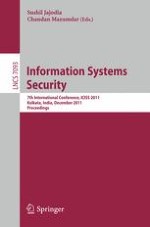This book constitutes the refereed proceedings of the 7th International Conference on Information Systems Security, ICISS 2011, held in Kolkata, India, in December 2011.
The 20 revised full papers presented together with 4 short papers and 4 invited papers were carefully reviewed and selected from 105 submissions. The papers are organized in topical sections on access control and authorization, malwares and anomaly detection, crypto and steganographic systems, verification and analysis, wireless and mobile systems security, Web and network security.
